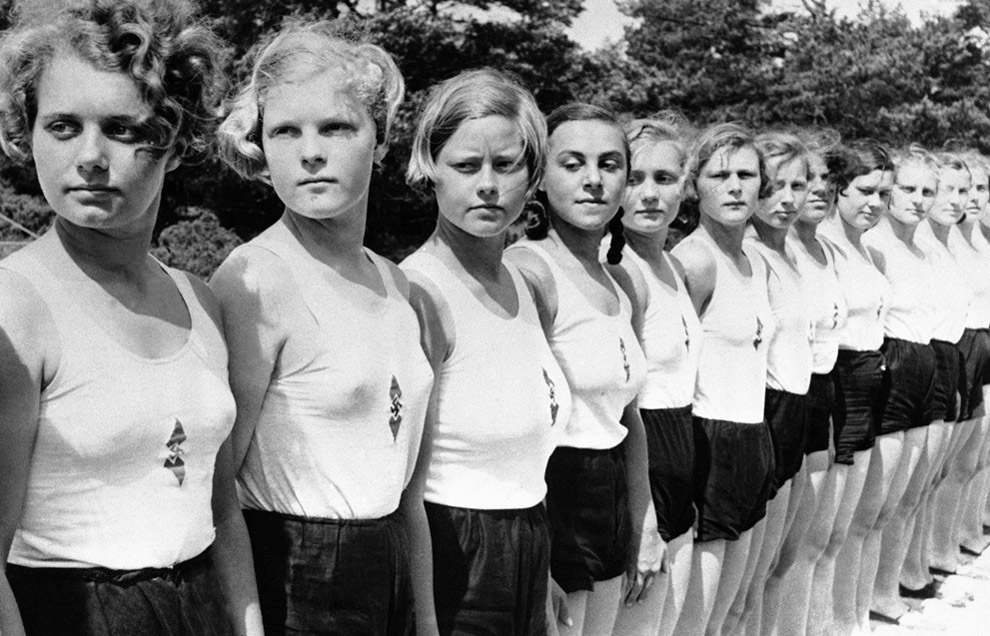Vadym Nazarenko (VN): One of your earliest works was research into the population of medieval Kyiv. Can you please summarize to our readers how middle-class residents of Kyiv lived in the first half of the 13th Century, what was their height, what was their way of life, what illnesses did they get sick from?
Oleksandra Kozak (OK): Kyivans were very diverse. Kyiv was always a “city of contrasts.” Each district had its own specific quality, perhaps because representatives of different social classes lived in each quarter. We know about numerous monasteries, palaces, and mansions owned by merchants and master jewelers living in the Upper City, while the longshoremen, sailors, masons and the like living in the Podil [Lower City - editor], along with, but apart from, the foreign guests who clearly formed their own group.
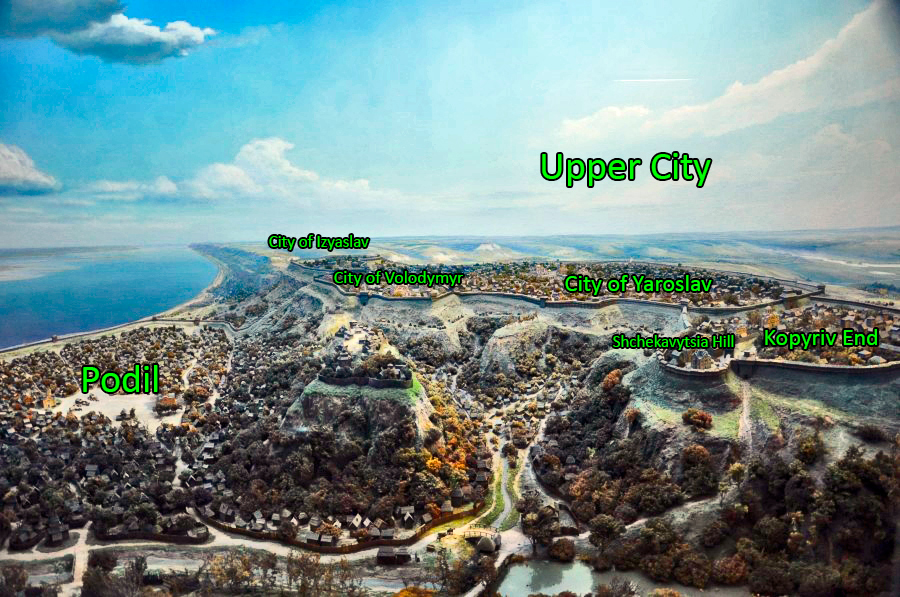
In medieval Kyiv, we’ve recognized only a few children’s burials. From 270 skeletons which I researched, only 50 – less than a third – belonged to children. This shows either a low rate of mortality in children or that we have not yet found children’s burial sites. Nonetheless, it is usual for the gravesites we find to be closely clustered. Perhaps Kyiv had a separate place for children within its graveyards. We determined one instance of children dying together in a group as a result of a specific epidemic and for several groups of children from Princely Kyiv the basic cause of death was scurvy, which is very strange since it was well known in Kyivan Rus’ how to treat this disease. The people who lived in Kyivan Rus’ commonly ate cabbage, onions, and garlic, but some still could get sick from scurvy. It is possible that they had become ill from some infectious disease, which brought on serious complications, and this infectious organism required large amounts of Vitamin C. Epidemics were frequent in medieval Kyiv. Up to 10 could occur every century. Basically, the majority of epidemics occurred in the late winter or spring, when there were fewer vitamins when there were no fresh vegetables or fruits and people’s immunities had weakened over the winter.
In the graveyards of Upper Kyiv, one cannot find many burials of young men or young women. It is possible that the young men, who served within the Prince’s druzhyna [an armed retinue in ancient Rus' that served the prince and constituted the main military force of the state - editor] may have perished in other places and were buried in the locations of their deaths. In those times women, perhaps because of some strong social custom, were not buried in the graveyards we investigated.
We are very fortunate to have uncovered a burial from 1240 (though it was a tragedy for Kyivans!) Usually mass military graves, dug during one specific moment in history, reflect the composition of the “living population” – that is, we have a horizontal “cross-section” of the population which lived at this place at this time. At the time of its siege and sacking, Kyiv was home to not only the citizens, but the druzhyna, and maybe even residents from nearby towns. We have found that the majority of burials from 1240 were those of young men and small children. We can assume that the attackers did not kill the women, but took them into captivity.
What did men get sick from in medieval Kyiv? We have determined that they only suffered from chronic illnesses or trauma. We’ve found plenty of signs of trauma, old inflammatory diseases, tooth illnesses. We have several situations, in which we suspect that old men suffered from vascular illnesses. Women had a high rate of mortality in their youth – from age 15 to 29 (this is within “Yaroslav’s City.”) We believe that women of this age died during childbirth. We found many instances of tuberculosis. Research on the cemetery on Patorzhynska Vulytsia yielded interesting results. We found a large percentage of the population which had on its bones changes similar to those which occur during leprosy. It cannot be excluded that a hospital or maybe even something resembling a leprosarium was found in this place beside the monastery or the church.
Regarding the height of residents of Kyiv, men who lived in Upper Kyiv had an average height of 170-175 cm, and men on Shchekavytsia Hill had an average height of 168 cm. In the Podil men showed great variation in heights: from 150cm to 180cm. Women in upper Kyiv reached heights of approximately 150cm, while those on Shchekavytsia reached 160 cm. Height was greater in certain social groups, especially among the elite.
VN: Did they have better nutrition?
OK: Better nutrition, and perhaps choice: tall men married tall women, and tall families arose through genetics. Height depends in part on genetics and in part on the appearance of stresses (such as hunger or malnutrition).
VN: The remains of people who perished during the time of the Mongol attack on Kyiv form the basic material for research on the city. One direction of research is “Battlefield Archeology.” What does data on paleopathology tell us about what happened in Kyiv in December of 1240? Do similar lines of research exist on battles which occurred on the territory of Ukraine?
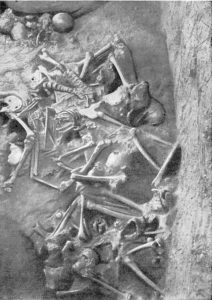
OK: In 1240 in Kyiv we have representations of three groups of people who died. The first group was located on Zhytomyrska Vulytsia. A defensive rampart had been built there and people died beneath it. The second group consists of men and women who were found on Volodymyrska Vulytsia
.
VN: Were only men found beneath the rampart? Were these defenders who died in battle?
OK: Yes, we found only men and most likely all of them belonged to the Prince’s druzhyna or took part in the city’s defense. We found upon them many signs of trauma – one’s skull broke inward with three or four mortal wounds. The majority of the wounds came from above and behind. Therefore, it is likely that the men were killed while on their knees or while lying down, or they were attacked from those standing above the rampart. The second group of people consists of those who we found in buildings on the street leading to the Church of the Tithes. Women and children were among this group. It is clear that they were trying to escape to the Upper City and hide in the Church of the Tithes after the lines broke. Most of the wounds were clearly lethal and inflicted from behind. Some do not have visible trauma on their bones. These people were likely asphyxiated during the fire in the city.
VN: The evidence shows then, that the slaughter was massive?
OK: Yes, it was massive. I worked with the remains of fifty people who perished in 1240. Last year beneath Poshtova Ploshcha, in the ruins of a building which collapsed during the fire, researchers found the remains of a six-year-old girl. Thus, the Mongols razed the Podil along with the Upper city.
VN: What about other battlefields?
OK: I am now studying materials from the historical town Zviahel (today Novohrad-Volynskyi). Zviahel belonged to the so-called “Bolokhiv Cities.” It was razed by Danylo of Halych [1201–1264, a prince, later the first King of Ruthenia - editor]. Several ditches with human bones (containing the remains of nearly 40 persons) were found in the city in 1993. Now we are trying to identify these remains. This is very complex. The remains of people, specifically those within the city, were gathered for burial. Deer, pigs, and dogs had gnawed the bones. All the bones were bleached, so they must have lain aboveground for a long time, maybe years, before being buried. Nobody lived in the city for a long time after it was sacked.
Separately, we are working on studying the bones gathered during [archeologist] Ihor Svieshnikov’s dig at [1651] Berestechko battlefield, and we plan to further his work, as there is still much which must be understood. We know that peasants, as well as professional soldiers, died on the battlefield among Bohdan Khmelnytskyi’s army. We have two groups here: the first group, found at the ford through the swamp, consists of Cossacks who stayed until the end, covering the others’ retreat from the camp; the second group is made up of locals who hid in the Cossack camp but then could not escape from it.
A fairly new and sensational discovery is a mound of decapitated skulls on the site of the Turkish camp near Chyhyryn [the capital of the Cossack state in the 17th century - editor]. We estimate that it dates from the end of the 17th century (maybe 1677 or 1678). We will see what the research shows!
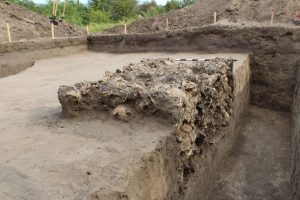
VN: One of your works was devoted to the population of the village of Stayky in the 17th Century. One of the conclusions of your research was that the buried men had frequently shotguns. What else can you tell us about the residents of this village?
OK: It was a small series of burials – only about 20 men. There were more men than women or children. A clear division existed among the men between local townsmen and foreigners, which showed itself in the shape of their skulls and their relative heights.
The people of Stayky suffered from tuberculosis, meningitis, and scurvy. We found many people suffered from scurvy. There was one very fascinating situation: we found the remains of a woman, and nearby to her were the remains of a child. The woman had arthritis of the vertebral joints. We suppose that she continually carried something heavy on her back. The child was sick with scurvy. One of the symptoms of scurvy is bleeding under even a minimal stress: it is enough to press with one’s finger to cause hemorrhaging. We found a hematoma on the child across its ribcage. It is possible that this woman carried this child on her back, tying the child across her with a cloth or some kind of belt. The child was only a year-and-a-half old.
In three children of Stayky we found hematomas on the back of their shins. These children were struck with rods on the back of their legs (as a punishment). We found signs on several men that they had been hit with bullets. We found specific changes on the collarbones of four men – the creation of additional bone tissue between their collarbones and shoulder-blades. These changes can occur as a consequence of continual pressure on the shoulders. Chronic trauma had occurred where the collarbone joins the shoulder blades, and the hemorrhaging gradually turns into bone-growth. These changes occurred in the foreign men with morphological differences from the local villagers. Another interesting discovery: one of the men had trauma on his head from an ax-blow to the temple. Nonetheless, he somehow survived such a difficult wound and even managed to live on for some time afterward.

VN: How was the way of life for the residents of Stayky? For example, what did children do? What does paleopathology tell us?
OK: This is difficult to say. Only much work carrying heavy loads would show itself. We found, for example, that children had arthritis of the spine. Clearly, they carried heavy loads on their heads or on their backs. We found several occurrences of so-called enthospathy – a change in the bones where they connect with the muscle tissue.
VN: Is it possible to better understand what the adults’ line of work was?
OK: Yes, things are much clearer. Women, for example, reaped the harvest.
VN: Women reaped the harvest?
OK: Yes, we see evidence that women were the ones to reap the harvest – they frequently performed wide swinging movements with their arms. We first noticed these changes in medieval grave-mounds outside Pereiaslav. We observed that many women buried there had the same sort of changes linked to wide swinging of the arms. They had well-developed musculature, similar to men’s. At first we couldn’t understand why that was, but afterward, we thought about it: the Pereiaslav Principality was a border region, the men were constantly at war, and women had to raise the children and harvest the crops. Similarly, in Pereiaslav we found very few medieval burials of young men. But we found many burials of women and old men. Clearly, the men died in battle and were buried where they fell. The women worked hard. We do not exclude the possibility that a similar situation developed in Stayky.
VN: Apart from the so-called population research, paleopathology also includes “osteo-biography” of well-known people. For example, researchers in Britain determined, during their investigations of King Richard III of England’s remains, that he was not a hunchback, but that he suffered from scoliosis. Is there such similar research on Ukrainian material? I know that you studied the remains of Semen Ivanovych Sukin, a governor of Kyiv.
OK: Similar research was begun in Ukraine in the 1960s. When the sarcophagus of Yaroslav the Wise was uncovered, Mykhaylo Herasymov created a reconstruction of Yaroslav’s exterior. Pathology was researched, with results conforming to that which is known about Yaroslav in the chronicles. This is what allowed researchers to identify him. The Ukrainian anthropologist and doctor Serhiy Horbenko, who worked in France, created reconstructions based on human remains. Notably, he made a reconstruction of Joan of Arc and even worked with the possible remains of Yaroslav Osmomysl [Prince of Halych in the 12th c.]. He did his own paleopathological research and showed that the remains bore evidence of Perthes disease (a congenital deformation of the top of the hip). The disease is inherited from the father. Yaroslav the Wise had a similar deformation. The presence of Perthes disease was one of the indicators that these remains could have been those of Yaroslav Osmomysl.
VN: Therefore Perthes disease is a possible “family” disease of the Rurikids?
OK: Yes, it is possible that Perthes was hereditary in the Rurikid dynasty. It is inherited from the father. We wanted to build a reconstruction of the possible remains of Yuri Dolgoruky [Kyivan prince who founded Moscow - editor]. However, we doubt whether the burial, uncovered beside the Church of the Savior at Berestove, contained his remains. Are they authentic? No.
VN: I remember that they wrote in the news that Dolgoruky suffered from osteochondrosis and many other illnesses.
OK: Yes, in those days many suffered from diseases of the spine. Particularly, people over 50 years of age. In the case we’re discussing, there is a great possibility that the skeleton discovered belongs not to a man, but to a woman. The skull is not present, but the pelvis bones are a woman’s. This person was very ill: the spine is in a terrible state and the joints were diseased. The skeleton had been worn out. This person died somewhere between age 55 and 60, possibly even older. I do not exclude the possibility that he could have been a man beside some other female remains, but I do not think that this was Yuriy Dolgoruky, because if this was a person who had been on constant campaigns, always fighting, the remains would have shown somewhat different markings. We submitted samples of tissue from this burial to Stockholm University laboratory for DNA analysis. We are waiting for results.
Regarding Semen Sukin, the governor of Kyiv, his burial was uncovered during excavations on the site of the Arsenal. His skeleton was held together very poorly. Not much information about him exists in written sources – just one or two lines in books. What can we say about his way of life? He was a cavalryman, and from a young age rode horses frequently. He had a well-developed musculature. Throughout his life, he suffered several notable physical traumas. For instance, his jaw-bone was broken.
VN: How was it broken? Did someone try to strangle him?
OK: Maybe he was strangled, maybe when he was a child it happened during some sort of game. His metacarpal bone was also fractured. This could have happened in two ways: either he hit someone hard with his fist, or he hit someone hard with his sword-hilt. Then we encountered a strange circumstance. For three years before his death the duties of the governor were carried out by other people. It was not understood why, and it was not too interesting to people besides myself. But our research showed that Sukin suffered from tertiary syphilis, which he clearly contracted in his youth. During the last years of his life, he could not work, not only from the complications of his disease but also from mercury poising. His bones had violet pigmentation. To understand the cause of this coloring, one must undertake the chemical analysis. We, unfortunately, were not able to do this. Otherwise, we could say for certain that this was either from a fungus which grew on the bones in the sarcophagus, or – and this seems to me more likely – from the effects of mercury poisoning. I think that this poisoning led to a very difficult illness and death for the governor.

VN: Mercury was the main treatment for syphilis?
OK: It was one of the most popular treatments. The ill went to mercury baths, they treated themselves with mercury steam, they drank mercury. People went bald from mercury “treatment.” It is possible that the fashion for wigs was a consequence of treatments for syphilis.
VN: The common belief is that syphilis arrived in Europe from the Americas, and that his illness was conveyed by Columbus’s sailors, and that afterward, it spread throughout the continent. What is the true history of such illnesses as syphilis, plague, or leprosy?
OK: Syphilis first showed up long ago. Remains of people infected with syphilis date back to the early Iron Age. But this was not venereal syphilis; it was an endemic, milder, form. We found one case of this sickness in the Scythian grave-mound in Bilsk fortress, and another case was found by Michael Shultz near to Novosibirsk, Russia. Syphilis became widely known in the early Middle Ages. We know of at least one case in medieval Kyiv. In the Americas, we know about cases of the so-called “Pre-Columbian” syphilis. Apparently, Columbus’s sailors exchanged “their” mild form of syphilis with the Native Americans and in consequence of this exchange a far more aggressive, venereal, form of the disease developed in both continents The disease gradually spread through Europe from Spain, to France, Germany, and Italy, and then to Eastern Europe. In connection with this, we have a very enigmatic discovery from Uspenskyi Cathedral in Kyiv. During its reconstruction, two burials were found. The remains lay side-by-side. Both remains showed a severe stage of venereal syphilis. We think that the burials of these individuals date from the 15th or 16th
Centuries. This is the earliest, but also the best known, clearest and most enigmatic case of the illness on Kyiv’s territory.
VN: Travelers who passed through Ukraine during the 18th Century spoke about the epidemic of syphilis in the country. For example, the Doctor of Medicine Samuel Gmelin in the 1760s wrote about the widespread of syphilis on the territory of the Hetmanate. Are these reports supported by your research?
OK: Yes, there was an epidemic of syphilis throughout all of Europe. In the 18th Century, 7 out of every 10 patients who went to London doctors had been infected with syphilis. And many did not even go to doctors. This was a common disease. Both the upper and lower classes suffered from it. It could not have circumvented Ukraine. Data from the excavation of the Arsenal support this: those burials date overwhelmingly from the 18th Century, and each third person buried there had syphilis. The epidemic was huge. Only with the appearance of a relatively harmless solution based on arsenic did the spread of the illness diminish.
VN: One more disease of the past is the plague. Roughly 30-40% of the population of Western Europe died of the Black Death during the middle of the 14th Century. What happened during that time in Kyivan Rus’?
OK: According to the chroniclers, the Black Death did not pass over Ukrainian lands. However, there are practically no known burials from this time. In Kyiv, on Frunze (today Kyrylivska) Vulytsia a large pit with burned bones was found at the beginning of the 20th Century. Researchers dated this burial from the time of the Middle Ages. It is possible that this was indicative of a plague epidemic in the 14th Century. The Black Death came to Kyiv several times, according to the chronicles: first, it came from the Tatars in Crimea, and after several years it came back to Kyiv from Western Europe via Novgorod. Several small epidemics, which Maksym Berlynskyi wrote about, are also known. In the 18th Century on the territory of Ukraine, two massive epidemics of plague occurred, the first in 1720 and the second in 1770-1771. The second was far worse. To understand and appreciate its horror, it is enough to read through the letters written by monks of Pecherska Lavra to those of the Vydubnytskyi monastery. If you read those letters you will perceive the scale of the inescapable calamity, of inescapable death. There was a letter in which one monk wrote that someone at the monastery had become ill. It was a “farewell” letter…
Earlier epidemics were also frequent, but these were not only of the plague. Apparently, there were epidemics of diphtheria, smallpox, and other bacterial and viral infections. Leprosy was first written about in the 4th-3rd Centuries BCE. I was fortunate to be among a group of German researchers who found what is still the earliest known case of leprosy in the world on the remains from a burial from the Elephantine Island in Upper Egypt. We dated these from the 4th Dynasty of the Old Kingdom (2600-2400 BCE – the time of the construction of the Great Pyramid of Cheops). Within this population were several cases of leprosy. Its manifestations differed little from those which we have found in later burials in other territories. This is strange since the manifestations of the majority of diseases change depending on time, conditions, and environment. I found the same manifestations which appeared on the Egyptian bones in Khmelnytskyi Oblast, in a collective grave of the Globular Amphora culture from the Eneolithic Age. The site dated form 2800-2600 BCE. During this period isolated incidences of leprosy occurred in the territory of Germany, and this suggests that the disease occurred earlier than we suspected, and its spread is different from that which we had previously believed. This suggests that our knowledge, until now, has been limited.
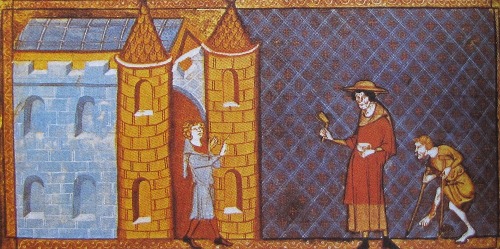
VN: During the Middle Ages in Western Europe and the Near East there was an epidemic of leprosy. How often did this disease occur in the territory of Kyivan Rus’?
OK: Leprosy in Kyivan Rus’ had an endemic, milder form and it existed here long before it was brought to Europe from the Holy Land by Crusaders. We can say that lepers in Kyiv and other Rus cities lived alongside the healthy. In the 19th Century, the well known Kyivan doctor Hryhorii Minkh wrote about the basic methods for isolating the ill: leprosaria (the form of which, apparently, came from Europe), villages in which the sick were settled, and houses in backyards within an estate. The last two methods were the oldest and most widely used in Ukraine. As the signs of leprosy could be found in all cemeteries, I believe that those who suffered from leprosy were able to live in their own families, but I will venture to add that they lived in relative isolation. The exception is the cemetery in “Yaroslav’s City” about which I already spoke. Generally, approximately 15-20%of the discovered remains of the population from the Princely Era showed signs of illnesses similar to leprosy. Lepers were common in the Middle Ages, and in later times. The University of Saint Volodymyr in Kyiv had a functioning laboratory which treated leprosy into the beginning of the 20th Century.
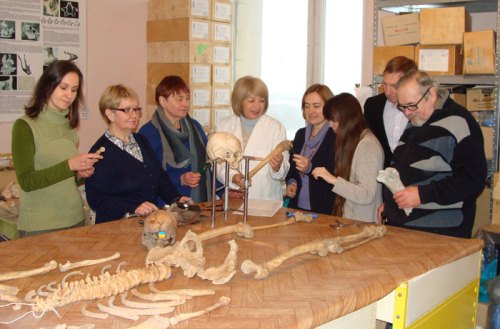
VN: What topics are you working on right now?
OK: Right now our informal group of paleopathologists is working in several directions. First, there is the reconstruction of professions (working on osteological complexes of horsemen, fletchers, crossbowmen, wheelwrights etc.). We are undertaking a project about “Amazons” – women-warriors of different eras, especially from the early Iron Age. We are studying the trepanation of skulls from the Bronze Age. I hope this project will finish with the creation of an, at least temporary, exhibition in a museum of archeology or history. We recently began a project on the research into economic strategies of the population from the Bronze Age. We are taking part in a project searching for the remains of King Danylo of Halych (1201-1264). Apart from that, I continue to research the population of medieval and early modern Kyiv and am now including genetic and other methods of research. We are considering, apart from that, the possibility of battlefield anthropology. I have already spoken about the excavation of mounds of skulls in Chyhyryn. This is expected to be a unique discovery and project which lasts several years. And all this is just a small part of what I do with my undergrad and graduate students! Unfortunately, we are a small group, and if you saw how numerous are the projects and directions, you would agree that we need to attract, however, we can, young students to anthropology.
Read more:
- How Moscow hijacked the history of Kyivan Rus
- Anna of Kyiv, the French Queen from Kyivan Rus
- Princess Olha of Kyiv: a golden page in Ukrainian history
- Putin’s ‘appropriation’ of medieval Ukrainian princess reflects more than historical arrogance
- Stolen ancient viking’s sword from the dawn of Kyivan Rus comes back home to Ukraine
- Ukrainian conflict is between 'heirs of Kyivan Rus' and 'heirs of Golden Horde'
- History as a weapon in Russia's war on Ukraine
- A different Rus: Why the Kremlin hates Ukrainian statehood
- Kings or Princes? Why Do the Titles of Rusian Rulers Matter
- A short history of the Ukrainian greeting “Slava Ukrayini!”
- Ukrainian neck ornaments: history and symbols
- Ukrainian parliament mulls requiring officials to call the Russian state ‘Muscovy’
- Tatar historian: ‘Russians are no more European than are the Tatars’



